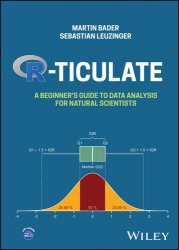 Название: R-ticulate: A Beginner's Guide to Data Analysis for Natural Scientists Название: R-ticulate: A Beginner's Guide to Data Analysis for Natural Scientists
Автор: Martin Bader, Sebastian Leuzinger
Издательство: Wiley
Год: 2024
Страниц: 224
Язык: английский
Формат: epub
Размер: 28.2 MB
An accessible learning resource that develops data analysis skills for natural science students in an efficient style using the R programming language.
R-ticulate: A Beginner’s Guide to Data Analysis for Natural Scientists is a compact, example-based, and user-friendly statistics textbook without unnecessary frills, but instead filled with engaging, relatable examples, practical tips, online exercises, resources, and references to extensions, all on a level that follows contemporary curricula taught in large parts of the world. The content structure is unique in the sense that statistical skills are introduced at the same time as software (programming) skills in R. This is by far the best way of teaching from the authors’ experience.
It has been over 30 years since Robert Gentleman and I began work on what would eventually become “R”. At the time, we had rather modest goals; we thought that we might be able to use the software to support our own teaching and perhaps some research.
The development of the concept of free software and the GNU system in particular was attractive to us from both philosophical and practical viewpoints. Our decision to release R as free software using the GNU license created by Richard Stallman was fateful. To our surprise, the software seemed of interest to a large number of talented developers who quickly became collaborators. The work of this group was instrumental in creating a platform that appealed to both users and developers.
Despite its now venerable age, R remains a useful tool. Thousands of add-ons have been created that have moved R into areas of application that we could not have envisaged when we started work on it. This book is an example of this kind of use. It shows that R is suitable as a companion software for those students who major in subjects other than statistics and mathematics.
If you put R to use, please do so in the spirit that it was created. Collaboration is a very powerful tool, and freely sharing the results of your work creates benefits for all, including you.
Our aim was to produce a surmountable, paced, 12‐chapter text which suits the typical 12 week (1 semester) layout of many undergraduate courses. Just like in our classroom teaching, we use easy‐to‐understand language to explain key concepts and strive to strike a balance between the practical application of statistical models and a conceptual understanding of the theoretical foundations. The content of the chapters can be used selectively, and we deliberately go deeper where we deem detail is useful. As such, the text may in part also suit postgraduate students of the natural sciences. Our philosophy generally suits the curious student's attitude of ‘wanting to know why’, but we make sure we summarise the key concepts for those who are after a simple ‘recipe’ to get there. Margin texts and dedicated boxes will help with this. We demonstrate the use of base R as well as that of more recent developments (Tidyverse) as we firmly believe that both have their place, and taking the best of both worlds makes most sense. Exercises and datasets are available online to save space and keep the volume of the text ‘light’, particularly for those who prefer to work with a hard copy. We hope this text will help you to R-ticulate yourself well in a data-driven world where statistical analysis and modelling skills are ever more important and in high demand with employers, far beyond the natural sciences.
Readers of this introductory text will find:
Explanations of statistical concepts in simple, easy-to-understand language
A variety of approaches to problem solving using both base R and tidyverse
Boxes dedicated to specific topics and margin text that summarizes key points
A clearly outlined schedule organized into 12 chapters corresponding to the 12 semester weeks of most universities
While at its core a traditional printed book, R-ticulate: A Beginner’s Guide to Data Analysis for Natural Scientists comes with a wealth of online teaching material, making it an ideal and efficient reference for students who wish to gain a thorough understanding of the subject, as well as for instructors teaching related courses.
Contents:
Preface
About the Companion Website
1 Hypotheses, Variables, Data
2 Measuring Variation
3 Distributions and Probabilities
4 Replication and Randomisation
5 Two-Sample and One-Sample Tests
6 Communicating Quantitative Information Using Visuals
7 Working with Categorical Data
8 Working with Continuous Data
9 Linear Regression
10 One or More Categorical Predictors - Analysis of Variance
11 Analysis of Covariance (ANCOVA)
12 Some of What Lies Ahead
Index
Скачать R-ticulate: A Beginner's Guide to Data Analysis for Natural Scientists
|